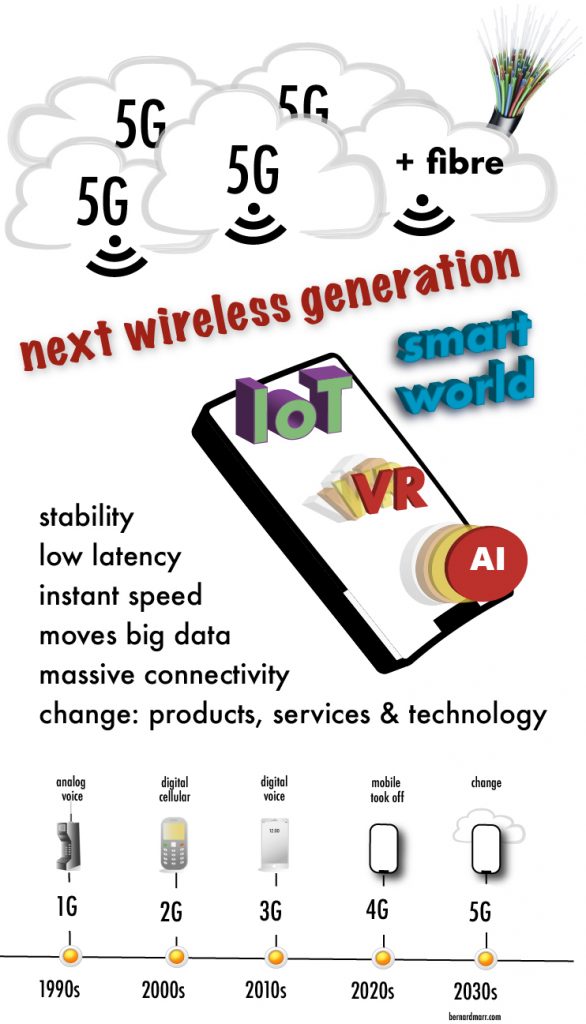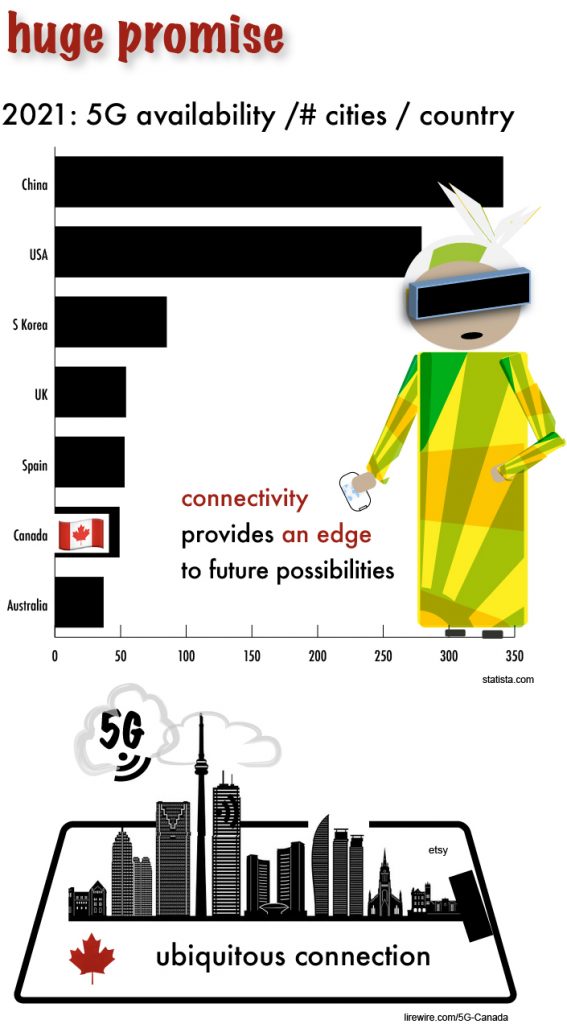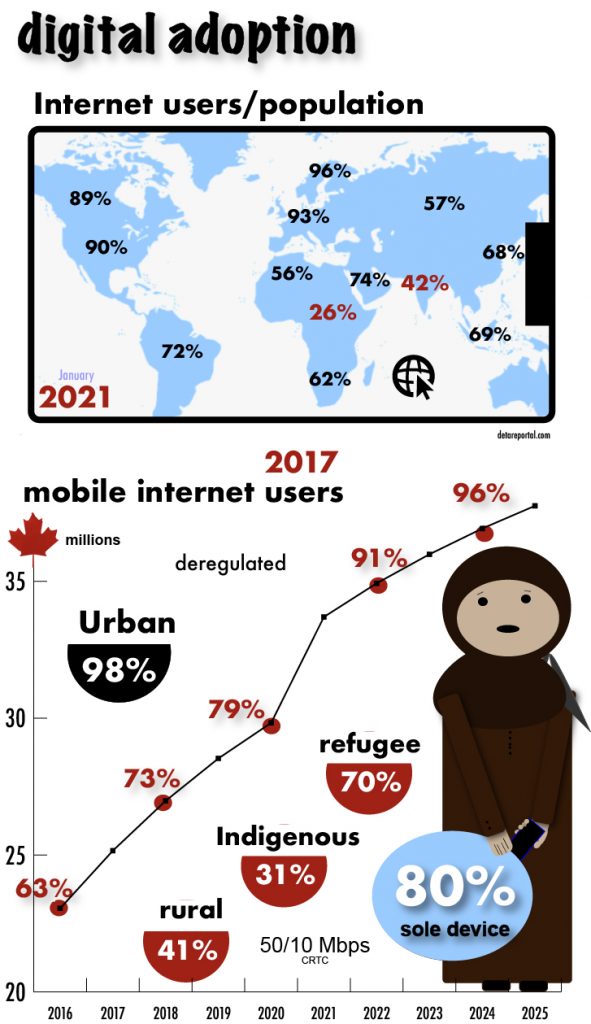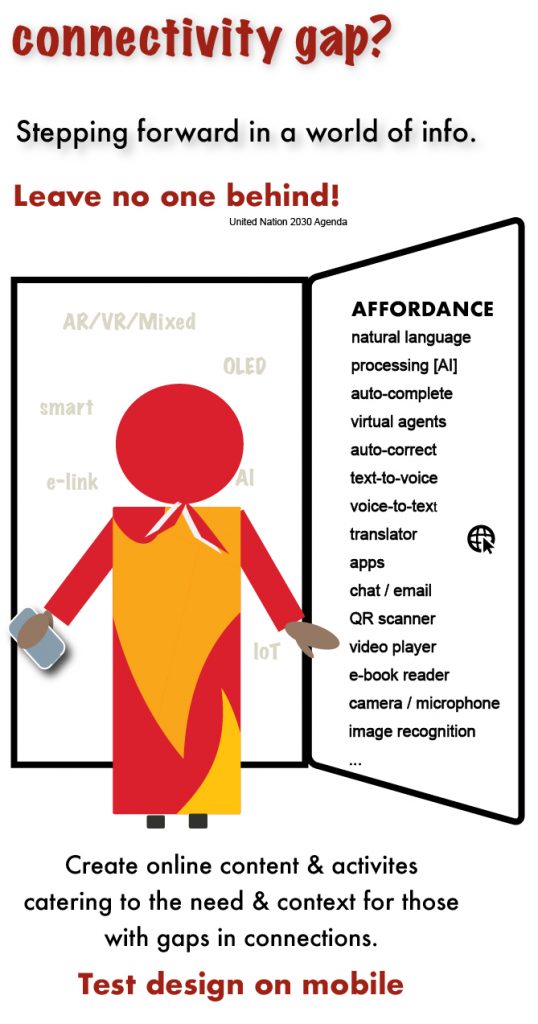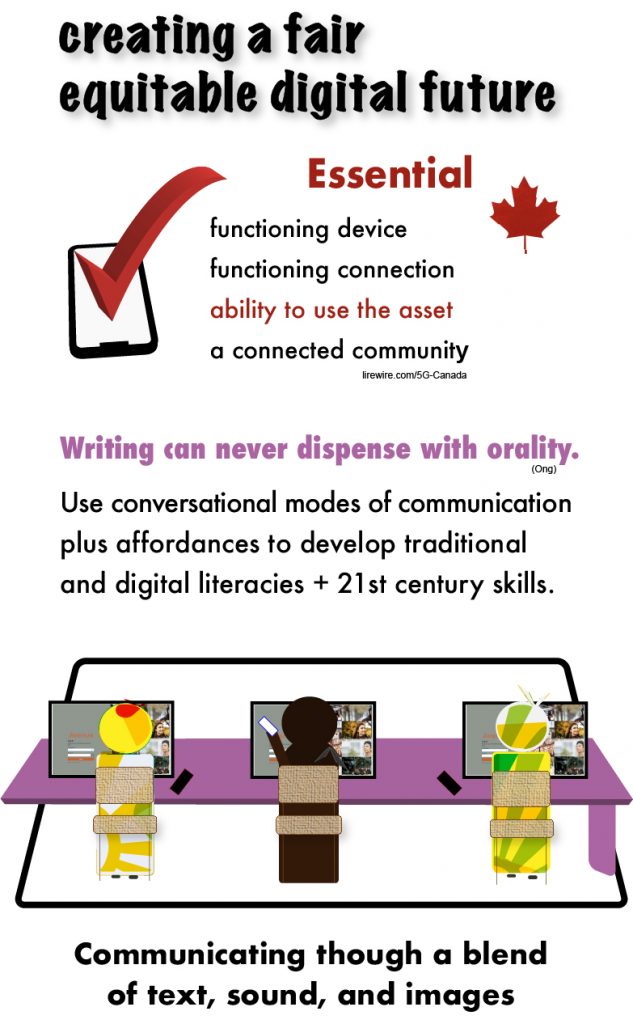Task 3: Speech-to-Text
Nick
https://blogs.ubc.ca/etec540njh/2021/09/26/task-3-voice-to-text/
Nick recounted a folk tale, The Tongue-Cut Sparrow that he seemed pretty familiar with for the speech-to-text piece, thereby producing a quite structured outcome. As a result, it was easy to quickly follow the storyline, with only a few spots requiring a second glance. Otherwise, the word substitutions, lack of punctuation, and capitalization did not interfere with the reading flow.
The brain’s capacity to read fluency regardless of missing or erroneous elements should not be surprising as the brain’s circuits have been adapting (Ong, 2002) to invariance in writing (Dehaene, 2009) since the creation of the cuneiform script by the ancient civilization of Mesopotamia (Schmandt-Besserat, D, 2009; Lamb and Jim, 2020)
The folk tale has two main characters: a friendly hard working humble man married to an older barren woman who is portrayed as a greedy shrew. However, what was unsettling was not the negativeness of the portrayal but that this depiction was encountered in an educational setting where inclusivity, understanding, and reducing inequities are goals. This is what brought me back to revisit the blog.
Elizabeth
https://blogs.ubc.ca/introspections/2021/10/13/speech-to-text-task-revisited/
Initially, I described my transcript resulting from the speech-to-text as an unpunctuated stream of thought like Kafka or Gao Xingjian’s stream-of-consciousness technique in a scroll-like document.
I was trying to weave two memories into a coherent, organized, coherent story, but I found that spontaneously delivering for over a five-minute duration was proving to be tricky. Moreover, this feeling of being taxed brought about the intrusion of the thought about the fairness of judging an individual’s English fluency in the IELTs test two-minute monologue.
My transcript, like Nick’s, did not include any writing conventions. I had also used pauses to indicate changes in thoughts but found out later that I needed to state the punctuation as one might due in a dictation exercise with ESL students.
Task 4: Manual Script
Nick
https://blogs.ubc.ca/etec540njh/2021/09/11/task-4-manual-script/
I revisited Nick’s blog for the fourth task due to curiosity to see the difference between his text-to-voice and the script versions of the Japanese folk tale.
In the handwritten script, the portrayal of the older woman stood out more. Perhaps this is due to that reading someone’s hand requires more attention.
The visit turned into a discussion about how often the stock character of older women is that of a shrew.
On another note, we both felt that the writing tools made a difference in the writing experience which brought joy. Nick’s choice of pen and paper adds to the quality of his experience.
Elizabeth
https://blogs.ubc.ca/introspections/2021/10/04/manual-text/
The affordance of the pen and paper released me from the virtual to the actual.
While Nick stays centred in the act of writing, the task took me on a few Proustian moments in recovering some lost time of a former self. The freedom of movement brought forth images of Plato’s cave dwellers, which resulted in returning to the tale, unfortunately, an online version and not searching for a copy from my bookshelves. Thinking about the tools led to examining sheets of paper from Richard de Bas’s paper mill, and the nib pens tucked away in a drawer. Even the legal paper brought back the history of working for a paper and visiting a printing press.
Task 6: An Emoi Story
James
https://blogs.ubc.ca/etec540jamesmartin/2021/10/17/task-6-4-emoji-story/
It can be surmised from the length of Jame’s story about the cat from outer space produced via his phone that he has fluency with social media. Furthermore, his strategy of obtaining the names (the designated noun phrase label) for the appropriate selection of these ideogrammatic icons is quite nuanced. It shows a concern for universal accuracy of outcome regardless of platform.
However, the intended meaning of the label does not ensure that the semantic layer will be interpreted in a like manner. For example, Rashidi (2020) concluded there were differences in the interpretation of emojis between genders. Moreover, this conclusion might extend to varied interpretations due to other sociodemographic constructs.
Elizabeth
https://blogs.ubc.ca/introspections/wp-admin/post.php?post=278&action=edit
Using the affordance of the phone for the emoji narration would seem logical, yet first, I composed mine on a word processor. Unfortunately, being ill-versed in the language of emojis, it, therefore, took several attempts to move beyond merely translating the written English code. The academic course content influenced the evolution of each attempt.
Puzzling over punctuating this iconic text brought forth the duh moment that I should be working on a messaging app. Nevertheless, I did not turn to the built-in chat of my iMac or iPhone but went to WhatsApp. The final copy directly applied knowledge from Kress, Bolter, and McCulloch, which created communication in real-time between two iPhones instead of producing a translated static one-voice written narrative. The mimicked dialogue was captured through screenshots.
Task 8: Golden Record Curation
Graeme
https://blogs.ubc.ca/gbaerg540/2021/12/01/week-8-golden-record-curation-assignment/
Wedding Song
- human voice
- complex fundamental human experience
- no choice
- under-represented
Queen of Night
- vocalist’s upper register
- colonialism
- decadence
- privilege
Flowering Stream
- human-instrument
- stringed instrument
- plucking + bowing
Johnny B. Goode
- electrical music
- shift of music
Tchenhoukouem
- percussion
- dynamic
- African
Morning Star and Devil Bird
- didgeridoo
- regional quality
- construction to extend human voice
Elizabeth
https://blogs.ubc.ca/introspections/wp-admin/post.php?post=401&action=edit
Wedding Song
- pubescent female voice
- lamenting being forced to marry at a young age
- female representation
- 49% of world population
- South America
Queen of Night
- female voice
- the mother: an evil sorceress
- pubescent daughter kidnapped and guarded by the slaves of by the”wise holy man”
- female representation
- 49% of world population
- Europe
Flowering Stream
- Chinese representation
- 18% of the world population
- Asia
Johnny B. Goode
- youth representation
- 18% of world population
- North America
Tchenhoukouem
- instrumentation
- Africa
Morning Star and Devil Bird
- didjeridu
- male vocalization
- aboriginal representation
- Australia
Graeme and I used the region as a criterion and human vocalization. However, he portrayed the diversity of humanity through musicality, while I left musicalness aside. I tried to be mindful of population, demographic, and continental representation.
Stanford’s Palladio algorithm created and populated Community 0 with Grant, Emily, Sheena, and Elizabeth from the Golden Record curation data.
I intended to view Grant’s blog because of the Palladio network; however, I accidentally stumbled into Graeme’s blog. Interestingly even though we were not in the same community, Graeme and I matched on five selections far more than half of the nodes in my network.
Networks are established by the closeness of the nodes, the members. Grant and I have the most matched selection (5), which is indicated by the closeness of the data visualization. Sheena and I have the least matched selection (3), indicating a greater distance in the path. In the following two task selections, I verified for commonality between the network members beyond the music selection matches.
Task 9: Networks of Golden Record Curations

Grant
https://blogs.ubc.ca/etec540dgm/2021/11/05/task-9-network-assignment-using-golden-record-curation-quiz-data/
Grant summarizes the assigned task. Then he explains how the storytelling data visualization results from algorithms that are run behind the scenes to make connections in the data.
He found that running the Palladio software was easy and explained the size of the bubble representing the nodes: the largeness represented the number of matching outputs. This explanation reflected the suggested course content.
However, he stated that the interpretation of simple data representation was influenced by personal context. This realization led to pondering about the limitations of visualization and the determination process of membership.
He used simple screenshots to provide examples from Palladio producing the light grey background colour.
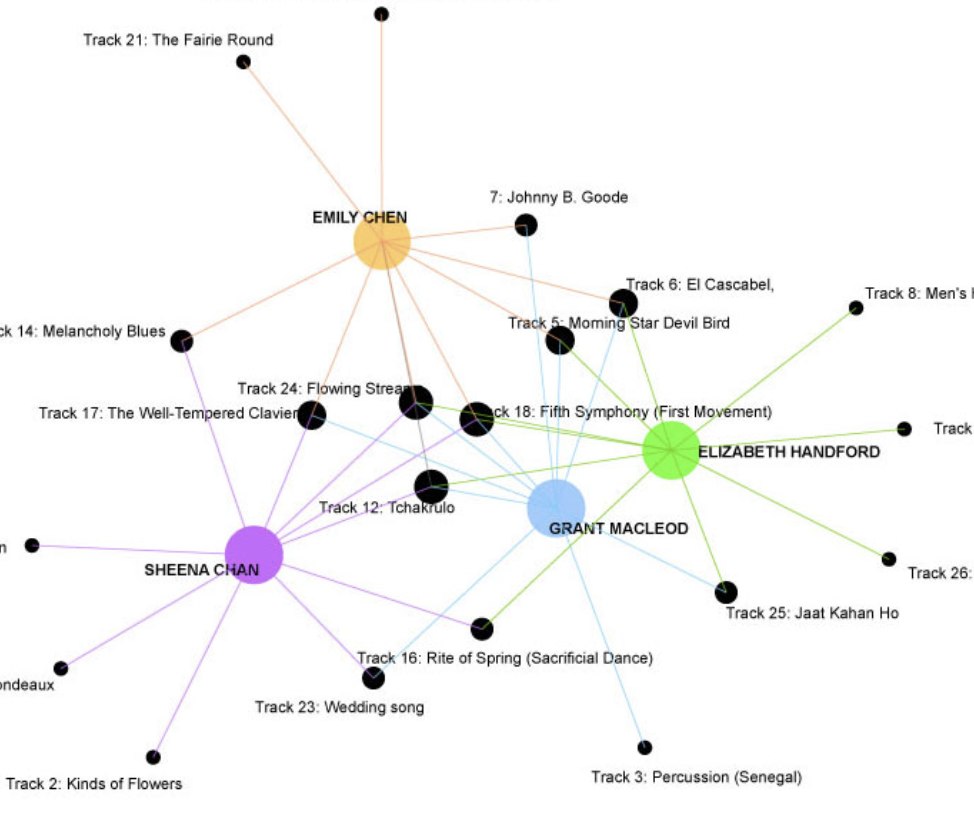
Elizabeth
https://blogs.ubc.ca/introspections/wp-admin/post.php?post=462&action=edit
There were two significant differences in Grant’s experience with the task and my own.
Like Grant, Palladio was easy to use. Nevertheless, I informed myself about the tool to determine the range of visualizations: tables and graphs, which could be produced with the class’ relatively small data set. From a previous experience working with Netlytics, another ethnographic tool, I understood networks, links, nodes, and size indication of frequency in the data set so time was spent looking at graph theory, simple data models, spaghetti data, and algorithms.
The second difference was creating visualizations with eye appeal. Once I figured out how to download an active graph, it was simple to take it into Adobe Create Cloud to differentiate the nodes by size and colour. The process of colouring links and nodes resulted in a more detailed examination of the content of the visualization. As Grant stated, visualization tells a story, but the digital world requires content staging so that the audience looks at that story.
Task 10: Attention Economy
Sheena
https://blogs.ubc.ca/shetec/2021/11/13/task-10-attention-economy/
Sheena was another member of Community 0 from the network task. Even though the overlap in Golden Record selection was low, there is some likeness in our reaction to the task, informed by Brignull, the conclusions, and the extended action of checking out the company website.
Sheena’s writing feels bloggish, focused and inviting to read. The length and language are accessible. The humanized touches are relateable such as the feeling of annoyance trying to navigate a poorly designed interface or being frustrated with dark design when unsubscribing.
She offers up just enough analytical content to engage the reader in further thought, yet stays on the fence so that polarized opinions still have a takeaway: straightforward UI design desired, but unprofitable vs dark pattern UI design deceptive, but generate clicks and profit.
Elizabeth
https://blogs.ubc.ca/introspections/wp-admin/post.php?post=631&action=edit
I struggled to find the balance of producing a blog that was both personable, yet academic. This struggle reflects my minimal contact with most social media. However, this may be a struggle that needs to be addressed as many students want a social media-like experience that still has content depth and integrity.
Sheena displayed two images; on the other hand, my post included seven. The habit of using images to support written and oral content arises from LINC’s obligation. Nevertheless, more importantly, obtaining these images from the task required a do-over, which brought about reflection, not upon dark patterns, but on online content, designed to avoid navigation snags for those with only a little online experience.
I avidly consumed the Biggar website and the assigned and suggested course content and then applied the insight into my LINC course converted from face-to-face to online, which will eventually morph into a blended format next spring. Thus, the task functions as a muse of that gleaned information.
The favoured authoring tool that all the examined posts used was writing with added images and a few hyperlinks. On the other hand, there was a lack of podcasts, music, videos, and animations even though all are possible in Word Press. With the ability to add plug-ins to extend functionality or add other features, this narrow choice of tools could be caused by habit, time restraints, or unskilled in the available assets. However, technology affords a more dynamic interactive experience, and the students expect it.
References
Ong, W. J. (2002). Chapter one: The Orality of language. In Orality and literacy: The technologizing of the word (pp. 1–11). Routledge.
Rashidi, U. S. B. M. (2020). Emoji: An ideogrammatic icon used in communication through a gender perspective[English for International Communications, International Islamic University Malaysia]. https://www.iium.edu.my/media/62014/EMOJI%20AN%20IDEOGRAMMATIC%20ICON%20USED%20IN%20COMMUNICATION%20THROUGH%20A%20GENDER%20PERSPECTIVES%20-%20UMMU%20SYAFIQAH%20BINTI%20MOHD%20RASHIDI%20-%202020.pdf
Schmandt-Besserat, D. (2009). “Origins and Forms of Writing.” In Bazerman, C. (Ed.). Handbook of research on writing: History, society, school, individual, text. Links to an external site. New York, NY: Routledge.
Stuff To Blow Your Mind, entitled “From the Vault: Invention of the Book,” Part 1
